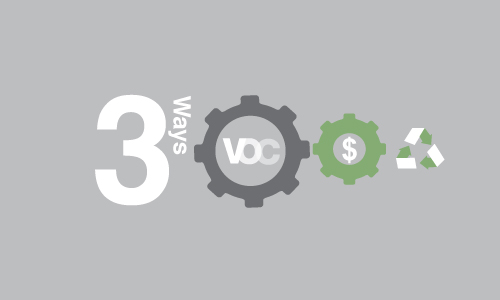As more awareness is developed around the damaging health and environmental effects of volatile organic compounds (VOC), the government is enforcing stricter regulations to control VOC in the manufacturing industry.
The Clean Air Act is one of the key pieces of legislation for improving the nation’s air quality and protecting the stratospheric ozone layer. Many industrial manufacturers have to install costly equipment and redesign their plants to comply with the law. Failure to do so can lead to citations and hefty fines.
Currently, manufacturers must bear the expenses related to VOC abatement, which impacts the operating cost and the bottom line of the business. Therefore, it’s vital to increase the efficiency of your VOC abatement processes so you can reduce the associated costs:
Capture and Recycle Energy
The process of VOC destruction emits a vast amount of heat, which can be captured and reused to initiate the oxidation process or for a variety of other purposes, such as heating other parts of the facility.
There are different energy recovery systems for capturing heat emitted from the abatement process, which can replace or reduce the need for other energy sources (e.g., natural gas burners or electric heaters). Some of these technologies include air-to-air heat recovery systems, air-to-liquid energy recovery systems, and air-to-waste heat boiler energy systems.
In addition, recycling the heat generated from the oxidation of VOC allows you to reduce the use of natural gas burner during the abatement process and lower the emission of nitrogen oxides.
Use Data Analytics to Improve Efficiency
Many modern VOC abatement systems are equipped with Internet-connected sensors (IoT), allowing you to collect data and closely monitor their operation to reduce maintenance cost and improve efficiency.
For example, with the right data analytics, you can identify equipment that needs to be repaired or replaced ahead of time to minimize unplanned downtime. You can also avoid the expense of replacing parts that are still functional, allowing you to lower servicing costs and avoid unnecessary maintenance shutdown.
Furthermore, when the equipment is operating optimally, you can reduce energy consumption and minimize costs.
Upgrade Your VOC Abatement Equipment
Outdated VOC abatement equipment (e.g., 7-10 years old) is costly to operate. You’re probably losing money every day if you’re using old equipment that’s not optimized for energy consumption and operational efficiency.
Choosing the right VOC abatement technologies can help lower costs and improve efficiency. For example, Regenerative Thermal Oxidizers, Catalytic Oxidizers, and Rotary Concentrator Systems are some of the most popular equipment among leading manufacturers.
Optimizing your VOC abatement strategy and setting up your facility to maximize efficiency is the key to lowering the cost of VOC abatement. Download our free Air Pollution Control Selection Guide to find the right solution.




